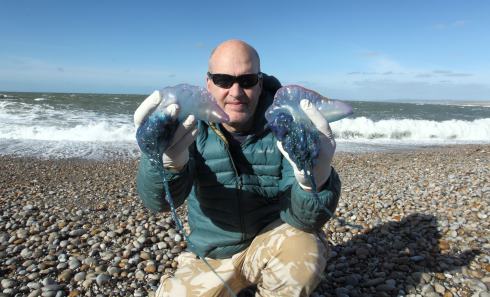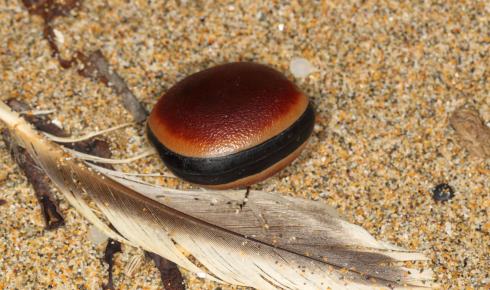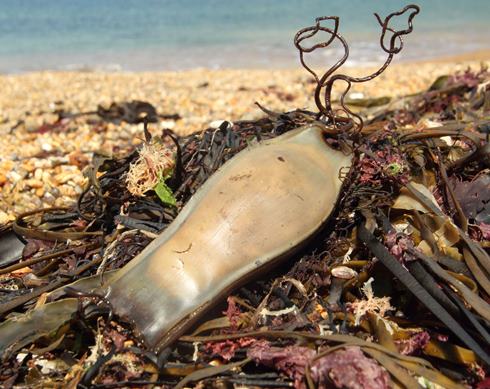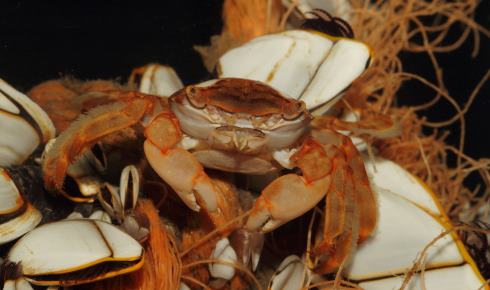How to…Beachcomb

Photographers and naturalists Julie Hatcher and Steve Trewhella explain the basics of beachcombing, and how it contributes to conservation and research
The Biologist 65(3) p26-29
Everything that the sea casts on to the shore tells a story. Some objects give us glimpses into the lives of marine creatures living nearby. Others speak of long-distance voyages on the ocean waves. Much of it tells us about our own lives and careless habits. Once you learn to read these tales, beachcombing can become an addiction.
Beachcombing probably originated as people gathered essential resources such as wood or simply picked up unfamiliar objects out of curiosity. Tropical drift seeds, or sea beans, for example, are carried across the Atlantic from the Americas by ocean currents. They were once revered in the Outer Hebrides for their supposed magical properties and were often handed down as family heirlooms. Some sea beans drift for up to 20 years, and are still able to germinate and grow once washed up on a distant shore.
In many coastal areas, there is a long history of beachcombing or 'wrecking' from a time when shipwrecks were a regular occurrence and offered an opportunity for locals to access valuable cargo.
Seashore seekers
While beachcombing is an enjoyable pastime, it also has an important role to play. The seashore is a highly dynamic environment, changing on a daily basis as the tide carries objects in and out, moves sediment around and occasionally reveals long-buried structures such as shipwrecks and fossil forests.
 A 'hamburger' sea bean found washed ashore
A 'hamburger' sea bean found washed ashore Beachcombers, often the first people along the coast, can witness both subtle and significant changes. They can flag up pollution incidents, such as waste spillage or dumping, oiled seabirds, or stranded marine mammals and turtles. Reporting these to the relevant authorities and organisations as a matter of urgency can instigate an investigation into the cause and potentially save the lives of distressed animals.
Beachcombers can also identify important areas for a particular species. The Shark Trust runs a national survey to record mermaid's purses, the empty egg capsules of sharks and rays. The species can then be identified by their shape and size, which can tell us about the populations of these fish along our shores, including the location of important spawning areas.
For most people marine species are hard to see in their natural environment but beachcombing can offer a fascinating insight into their lives and behaviour. At certain times of the year, especially following rough weather, the developing eggs of squid and cuttlefish can wash up on the beach, revealing the breeding behaviour going on just beneath the waves.
 An egg case from a lesser spotted dogfish, commonly known as a mermaid's purse.
An egg case from a lesser spotted dogfish, commonly known as a mermaid's purse.A perfectly round hole drilled into a shell tells us that the owner fell prey to a predatory sea snail such as a dogwhelk or necklace shell. Using chemicals to dissolve the shell, and a hard tongue to scrape a hole through to the soft interior, these tiny predators deliver a grisly end to their victims.
The nomadic and the unusual
Prolonged onshore winds can drive some of the more bizarre marine creatures onto our shores. Animals that live on or near the surface of the sea, drifting with currents, have little or no control over where they are carried. Jellyfish inhabit coastal waters and can undergo population explosions resulting in mass strandings under certain conditions, creating a wildlife spectacle, from tiny mauve stingers to metre-wide barrel jellyfish.
Pleustonic (floating) animals such as by-the-wind sailors (Velella velella) and Portuguese man o' war (Physalia physalis) live out of sight of land, travelling at the whim of winds and currents. They inhabit the interface between sea and air, half above and half below the water, with poisonous tentacles dangling beneath the surface to catch prey. These species have a distinctive colour – blue, pink and mauve – to camouflage them against the sky above as well as the sea below. They do not travel alone but are accompanied by a community of highly specialised predators, including violet sea snails and the pelagic nudibranch Fiona pinnata.
One of the oceanic animals that never ceases to amaze people when found stranded is the goose barnacle, a species of crustacean related to crabs, shrimps and barnacles. The bizarre-looking animals can wash ashore in colonies of thousands or singly and in small groups attached to drifting timber and litter. With their writhing worm-like stalks and shell-covered body opening to reveal grasping feeding apparatus, they are truly other-worldly. They have a nomadic lifestyle, settling as larvae on drifting objects in the open ocean and feeding opportunistically on plankton and small surface-living animals as currents carry them along.
The natural and man-made objects occupied by goose barnacles may also host a diverse community of tropical and oceanic animals. In recent years, beachcombers have discovered increasing numbers of the Columbus crab (Planes minutus) along our shores. The previously rare visitor is a purely pelagic (open ocean) animal inhabiting drifting objects on the ocean surface, sometimes even hitching a ride on turtles.
 Columbus crab (Planes minutus) found in the UK having crossed the Atlantic ocean
Columbus crab (Planes minutus) found in the UK having crossed the Atlantic ocean Close inspection of marine debris by beachcombers has revealed a wealth of other tropical species, some with eggs, arriving on the continuous conveyor of trans-Atlantic marine litter carried here by the Gulf Stream. As many of these species of molluscs, worms and other invertebrates are alive on arrival, further research is being carried out by the scientific community to investigate the potential threat these non-natives could pose if they were to settle and spawn here.
Marine litter
In recent decades, plastic litter such as bottles, cigarette lighters, toothbrushes and fishing net has dominated our beach strandlines. Marine litter is a global problem of immense scale and consequence, both to animals and humans. Cargo spilt from ships, balloon releases, cigarette butts thrown from car windows, disposable barbeques left by uncaring beach visitors and disposable items flushed down toilets – every day more and more of our rubbish enters the sea and precious little is ever removed.
The #2minutebeachclean is a growing movement where beach visitors spend two minutes of their time removing litter and posting photographs of their efforts on social media, encouraging others to take part. You can borrow a litter picker, as well as find out more about the project, at the various #2minutebeachclean locations across the country.
More information is online at www.beachclean.net.
If you are new to beachcombing, there are a few things to take into consideration:
Check the tide times before you go so you don't get cut off by the incoming tide and always keep out of reach of the waves.
You only need good outdoor clothing and a bag or bucket for your finds – no specialist equipment is required.
Take a reusable water bottle with you, as you may walk further than you intended.
A smartphone or camera is always handy in case you find something you can't identify or you need to report an incident.
Particular species will vary depending on where you are in the country. West coast beaches bordering the Atlantic are more likely to be home to oceanic animals, while more sheltered areas may be dominated by local species. Those adjacent to rocky shores will differ from places with mainly sandy seabeds.
Rotting piles of seaweed might not strike you as a valuable wildlife habitat. In reality, these will contain myriad species, ranging from tiny mites and springtails to larger predatory insects, which in turn provide rich feeding for small mammals and birds.
Ideally, only man-made debris should be removed. Driftwood and rotting carcasses provide vital food and shelter for rare and often endemic strandline species. If natural objects are collected for identification or education, ensure that this is limited to one or two specimens, as large-scale removal can be detrimental to this fragile habitat.
Husband and wife Steve Trewhella and Julie Hatcher are naturalists based in Dorset. Steve is a professional wildlife photographer and Julie works in marine conservation. Together they have authored The Essential Guide to Beachcombing and the Strandline and In the Company of Seahorses.
1) Trewhella, S. and Hatcher, J. The Essential Guide to Beachcombing and the Strandline. Wild Nature Press (2015).
2) Facebook: The Essential Guide to Beachcombing and the Strandline Twitter: @UKBeachcomber
3) Report mermaid's purses via The Great Eggcase Hunt Project


